

The unseen GREAT WESTERN
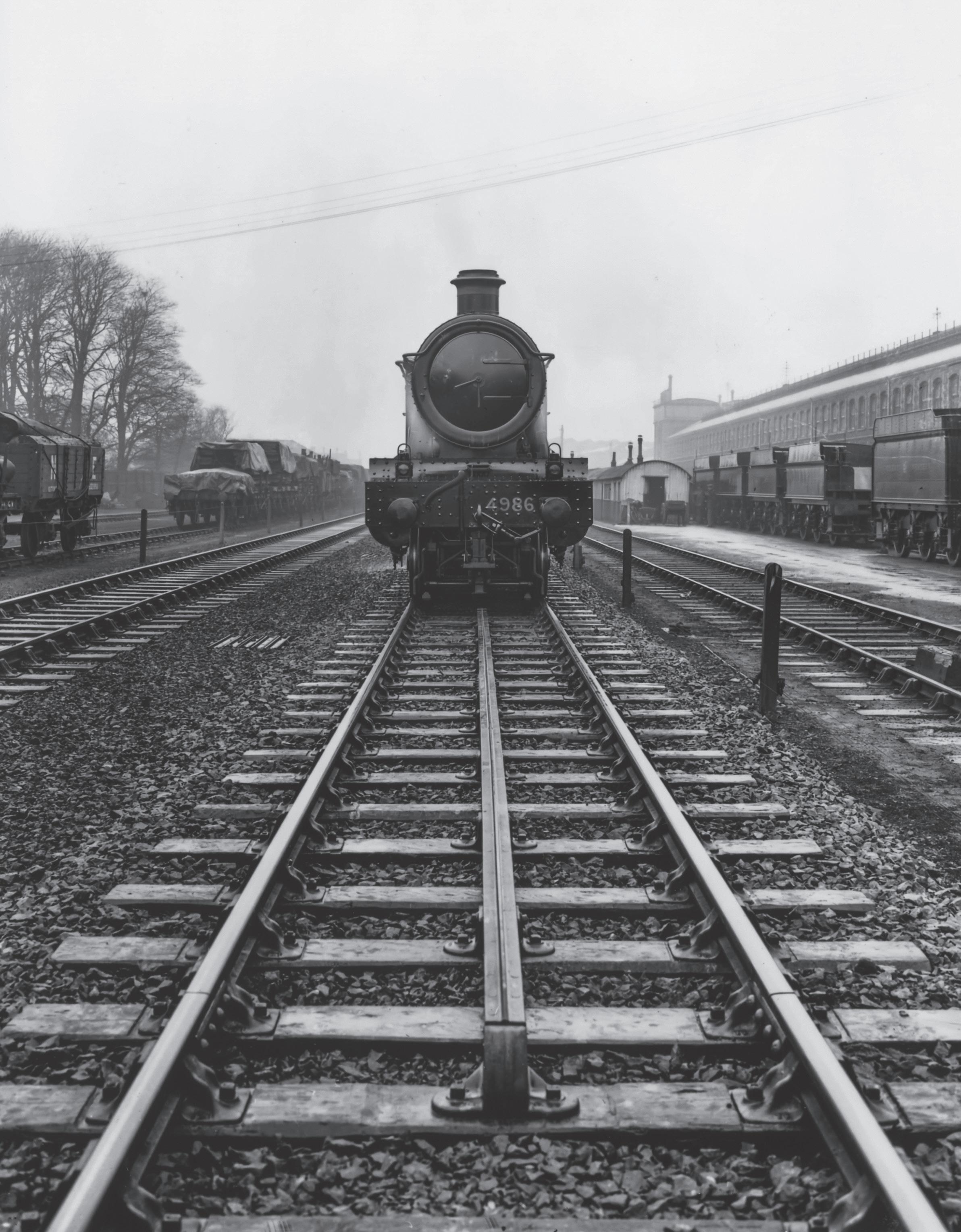
Images from the Harry Collection at STEAM - Museum of the GWR, Swindon
INTRODUCTION
This book is aimed at a specific audience, the Great Western enthusiast. It is to be hoped it may perhaps find its way on to shelves of some others but I will not be so naive to think it will appeal to many who follow ‘other’ railways.
Sticking my own neck out, I have always been primarily a GW man; albeit with a leaning towards certain aspects of other systems and designs as and when the mood takes.
In consequence I have devoured numerous tomes on my pet subject(s) with the book shelves at home groaning and my respective wives given up passing comment when yet another book arrived. (Note; despite the deliberate use of the plural ‘wives’ I assure all it has only ever been one at a time.)
Being serious now, in consequence of amassing a collection of books running well in to four figures plus, and having been involved for many years both in publishing and the retail arm of railway books I think I can say that literally thousands of images have passed before me. Even so it is still a privilege to see something new and there certainly is still plenty to be uncovered.
Coming to work at STEAM as a volunteer in the library I was made aware of an archive I had personally never previously heard of, the ‘Harry’ collection. How, what, why ‘Harry’ is a story in itself and I am most grateful to Elaine Arthurs, Collections Officer at STEAM for describing its journey on page 104.
From the perspective of a photographic researcher the collection is a veritable gold mine, countless images compiled from a variety of sources including the official GWR/WR collections and which to me are new or show items from a different perspective.
Because many are, to me at least new, the choice of title is therefore obvious, however I am fully aware there will be some that are perhaps familiar to readers, whilst others may look similar but are perhaps seen from a different angle.
Of the official images, I suspect a few are ‘office’ or ‘file copies’, and it is very likely the negatives for these simply do not exist any more.
I should add this is also a book that has been some time in the gestation. The reason simply that I wanted to get it as right as possible. I will also state I do not for one moment profess to be an expert, instead one who has a working knowledge in various subjects and perhaps a greater or lesser appreciation in others. Asking questions of and securing answers and opinions from others is what takes the time; but can also be so rewarding.
In setting out this work I also wanted it to be a book of some surprises, hence I have deliberately ignored the convention of introducing views by time-scale, subject, or geography. Instead it is presented in what I hope is the simpler order or ‘images that work well with each other’.
The 100+ views that follow represent only the smallest fraction of the 27,000 plus images and other material within ‘Harry’ and for the present concentrates (not exclusively) on rolling stock and locomotives, for variety we have also strayed into the early BR era on a few occasions. Certainly not all within ‘Harry’ is suitable for reproduction but it is to be hoped what is presented in the pages that follow is a flavour and could lead to more in the future.
Kevin Robertson, Lambourn 2025.
ACKNOWLEDGEMENTS
Without the help of others, the information on the following pages could not have been compiled. Elaine Arthurs, Mike Barnsley, Jeremy Clements, David Collins, Amyas Crump, Steve Gregory, Andy Malthouse, Bob Meanley, Allan Pym, Andrew Royle, Dennis Troughton, Marlene Wheeler plus all the other library volunteers who have been valuable allies, I express my gratitude to them all.
In addition reference is made in the captions to specific books written by various individuals most of which will already be familiar to followers of the Great Western Railway. The intention of any author is to enhance knowledge already available and this is indeed the aim of this work but to also highlight the vast archive that exists at STEAM running to in excess of 100,000 items.
Note: ‘Artificial intelligence’ has NOT been used in the compilation of this work.
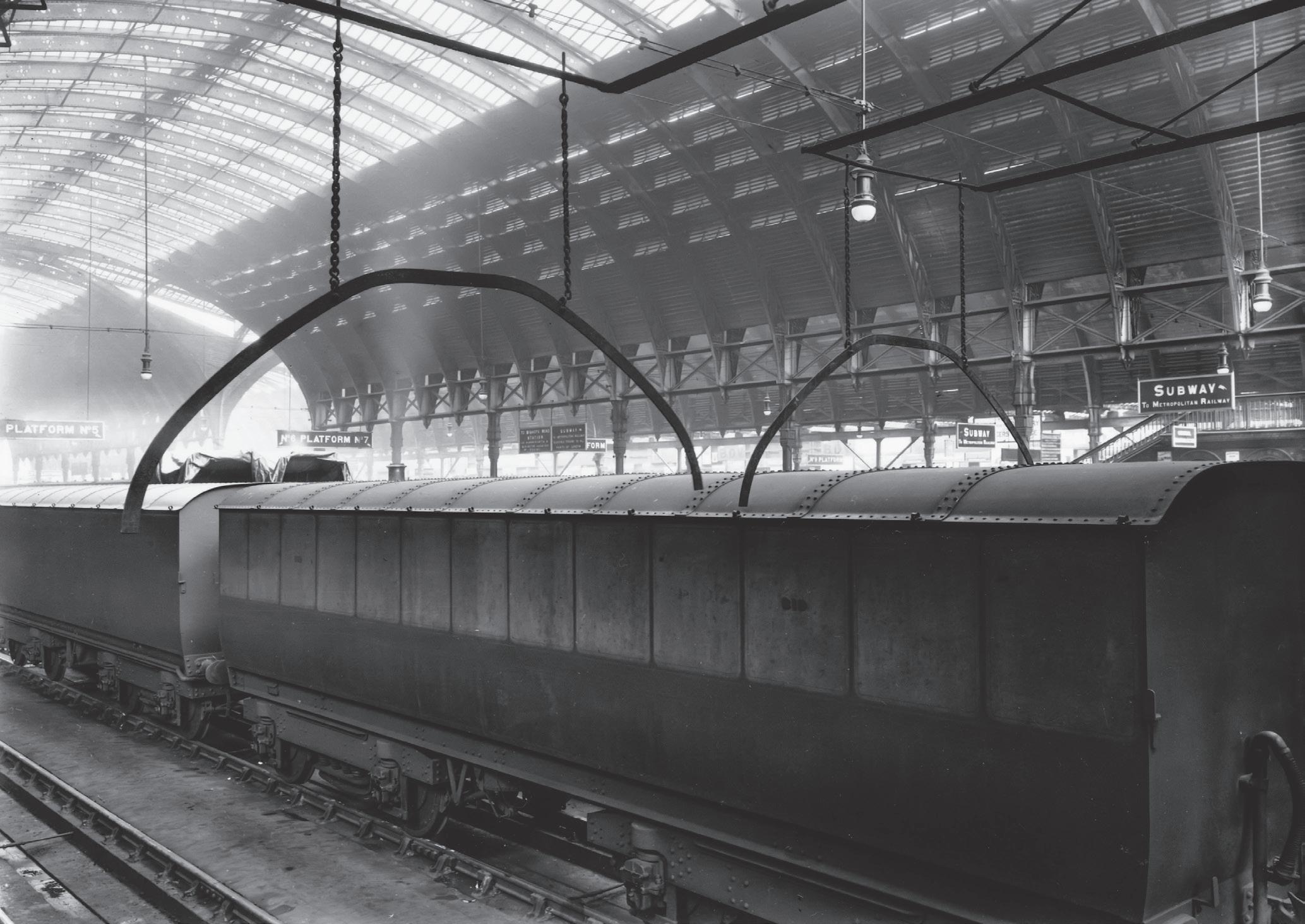
An unusual set of five vehicles were the Bullion vans built by the GWR under three separate Lot numbers and to Diagrams M16 and M17. First to appear were two vehicles Nos 791 and 792, to Lot 996 on 11 April 1903. These set a new standard and understandably when considering the load they would carry had bodies of all steel construction. They were non-corridor and could carry a load of 16 tons distributed. A pair of heavy plate-frame Dean bogies was fitted. Interestingly they also had eyelets along the roof line for communication cord purposes which were retained throughout their lives. Two further vehicles this time to Lot 1139, Diagram M17 were built in 1908, the difference now that they ran on pairs of 9’ American bogies (these were the type of bogie having both vertical helical springs and horizontal leaf springs), this latter pair, Nos 819 and 820 had a wheelbase of 33’. Again they were fitted with roof eyelets. A final vehicle No 878, again to M17, Lot 1220 was built in 1908. It was identical to the 1908 pairing excepting it did not possess the roof eyelets. Dimensionally all were 36’ x 8’ overall with a maximum internal height of 7’. Initially their sole purpose was the safe transfer of bullion between Paddington and Plymouth. Of principal concern was the security of goods in transit and apart from the type of construction they also only had access doors on one side; the other side as seen here blank, (note Russell reports ‘...some of the vehicles had doors on one side only...’, and by deduction he means 819, 820 and 878). Clearly then there must have been some pre-planning to ensure that at Paddington a train containing one of more vans was routed into the correct platform! Even so the whole operation of these vehicles raises a number of interesting questions. Firstly did the transfer of gold bullion only become important at the start of the 20th century? If it was taking place earlier, does this mean there was concern over security or had an incident occurred? We know that bullion van(s) were often included in the formation of an Ocean-Liner service where they were always marshalled immediately behind the tender, so does this mean there was a human security presence either within the vehicle or on the actual train? As built, the vans would have been out-shopped in the crimson lake livery of the period, including the final vehicle No 878 (see Russell Part 2 page 52).
Realistically all five would spend most of their lives in standard chocolate and cream. Shown on the ‘88D’ model website No 878 is seen in colour at Snow Hill and still retaining these colours. It also proves the point the vehicles were not restricted solely to the Plymouth service - were they in fact used for any other purpose other than bullion - although possibly No 878 was then carrying a similarly valuable load in the Midlands. Branding details are known for three of the vehicles, Nos 819 and 820 ‘Return to Plymouth’ and No 878 ‘Return to Paddington’. One change is known with No 820 in 1938 when it now instead read ‘Return to Paddington’. Branding for the first two vehicles is not reported.
At least one, No 792, was repainted in BR ‘plum and spilt milk’ and the same vehicle was also noted later in all over maroon. For specialist vehicles three at least had a long life, No 878 withdrawn in 1959 with Nos 819 and 820 lasting until 1967. The fate of the first two vehicles, Nos 791 and 792 is not reported. In this undated image two vans Nos 819 and 820 (identified by the bogies and roof eyelets - assuming no bogie swaps had taken between this pair and the first two vehicles), are seen in Platform 4 at Paddington and possibly in different liveries; note too the rear of the lorries drawn up on the platform which may well be being used for unloading. The vacuum hose has also been uncoupled from the leading van. Away from the vehicles loading gauges still in position over platforms 3 and 4. HC4 088 (6261)
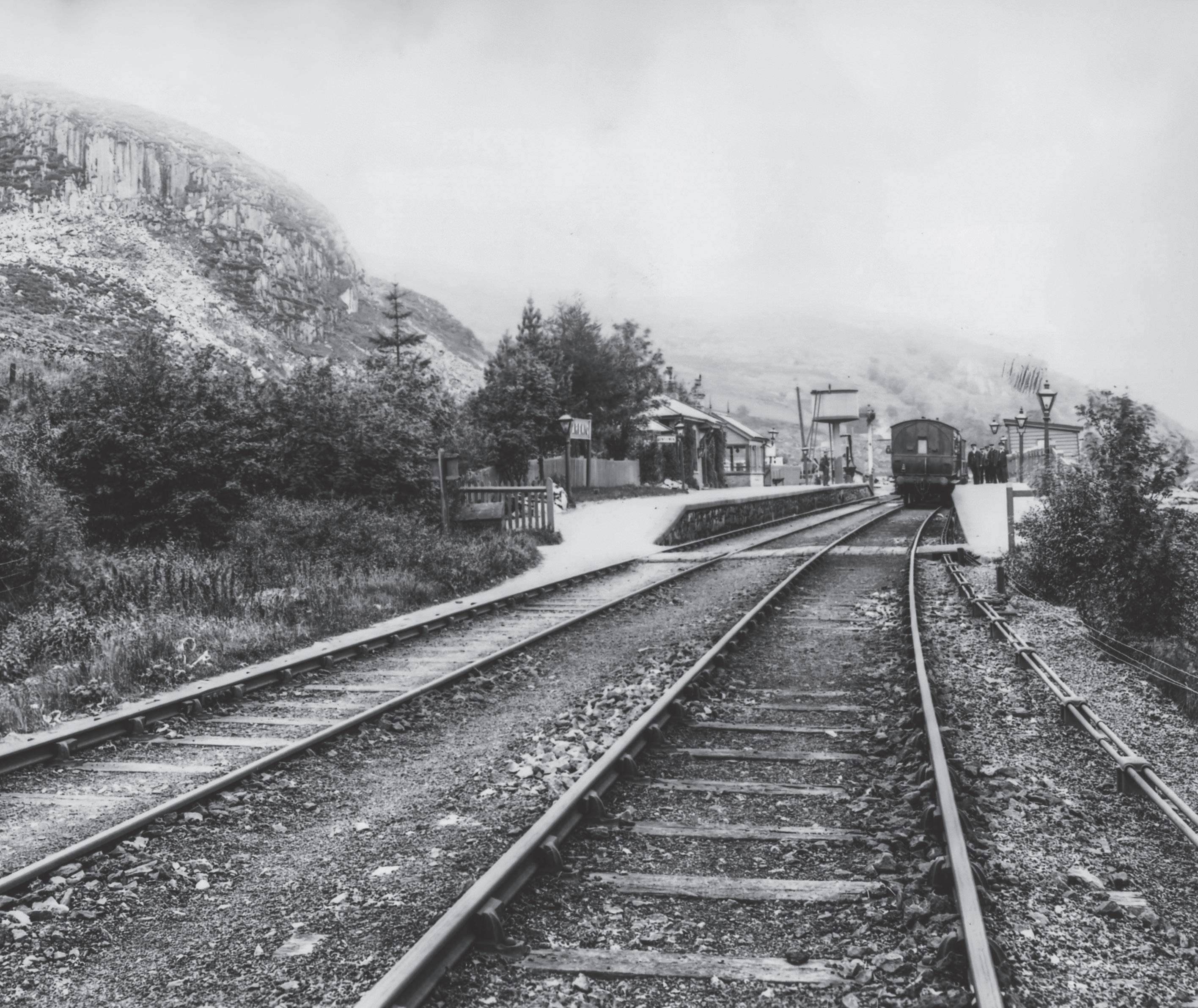
There are several files of station views within the collection and that does not include the ‘station’ files separate from ‘Harry’. Be aware however, not every station is featured in either archive and even if a particular location is included it may be a ‘standard’ view - meaning seemingly everyone who ever went to the location took the same basic image! Here we have Arenig on the line from Bala Junction to Blaenau Festiniog. The station was one of five crossing places on this 25½ mile single line, the other places where passenger trains might cross being Bala, Trawsfynydd, Festiniog and Manod. The station served a thinly populated area but lack of passenger traffic was made up for by the nearby granite quarry which provided ballast for much of the GWR. Operation of this railway in its early years would have been interesting. Opened as a private concern in 1882 at first there was no direct connection beyond Festiniog and passengers wishing to continue their journey had to board a narrow gauge train to Blaenau. This arrangement continued until the following year when the route north of Festiniog was converted to standard gauge although narrow gauge trains continued to operate until September 1883. Mixed gauge working did not just occur in the south! The independent company that had promoted and built the railway was eventually absorbed into the GWR in 1910. The view is looking towards Blaneau with the main building and signal box on this platform. The view is undated and appears to show a passenger working with tail lamp affixed; perhaps a ‘short working’ which has arrived and the engine will then return the train whence it came. Inside keyed track is also visible. Just visible is the signal box which dated from 1882 and lasted until closure. The original configuration is not known but on 18 October 1905 is was reported to contain a 25 lever frame at the larger 5¼” centres with stud locking. Until about 1940 a 2’ gauge narrow gauge railway had brought stone to the station but this was then replaced by a conveyor where it entered a crusher close to the station. The actual stone was also in close proximity to the station and before any blasting took place the railway had to confirm the timing was acceptable. Arenig was closed in 1960, single figure passenger numbers per day meaning the decision was inevitable. Freight between Bala and Blaenau continued until 1961 although part of the track bed was subsequently deliberately flooded to form a reservoir for Liverpool Corporation. HSA3 008 (100800)
The unseen Great Western
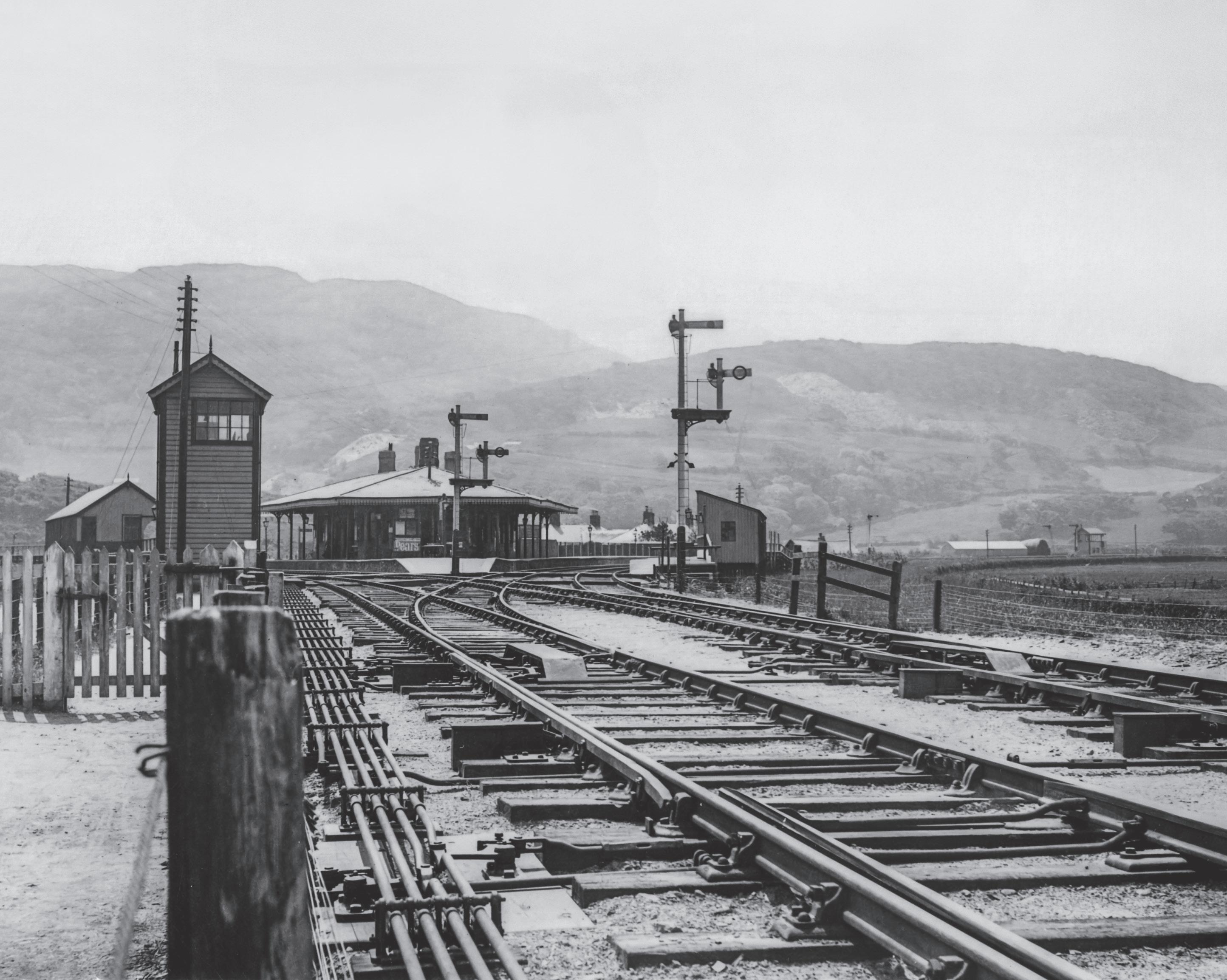
The important location of Barmouth Junction on the former Cambrian main line. Here the railway forms a triangle with the Cambrian branch to Dolgelley and which in turn forms an end-on junction with the Great Western line from Bala Junction. This image is taken from the north end of the triangle with the main line from Pwllheli behind the camera and the main line to Dovey Junction to the right. That to the left is the branch to Dolgelley and eventually Ruabon. Today it is only the Pwllheli line that remains open. As with many locations the railway here opened in stages and with facilities that grew as time progressed. First was the line from the south to Penmaenpool (on the way to Dolgelley) in 1865 this later became known as the loop. The main line, but as a this stage at a terminus, followed in June 1867. For a month trains could not cross the bridge over the estuary at Barmouth and passengers and goods were conveyed by horse drawn transport until the main and branch lines opened to passengers on 3 July 1867 and goods on 10 October 1867. The land hereabouts was mainly consisting of marsh and at the time of opening much of the railway had to be floated on brushwood whilst the station needed piling. In respect of access it was similar to that at Dovey Junction with poor access from the nearest road via a ‘grace and favour’ arrangement or else by trespass. The view is of the North signal box, at one time known as the station box. This worked to South box so far as the main line was concerned, and to East box for the line to Dolgelley. The loop making the third side of triangle, and on which there was never a passenger platform, allows train to run direct from the direction of Dovey Junction to Dolgelley without the need for the engine to run round or interfere with traffic already in the station. Considering that today the station is still open as an unstaffed halt although without even so much as a passenger shelter - and it can certainly blow at times. The stopping place was also renamed Morfa Mawddach in 1960 to avoid confusion with the similarly named Barmouth station. Under Great Western ownership the location was an important interchange and for a time there was also a Camping Coach located here. Back in time there were drainage ditches alongside the loop and a 4’ gauge tramway to some nearby quarries although this had ceased use by 1911. Apart from the expected marshland within the triangle there were also four railway cottages each with their respective garden, a pigsty and a cattle shed. The signal box seen here was timber and opened on 1 May 1892. (It lasted under the Great Western until 1931 when it was replaced.) Inside was a frame of 32 levers. In this view the signals are all of Cambrian (contractors) origin. On the outside of the left hand running rail there is a fouling bar, an unusual but not unique position for such a safety device. (Most fouling bars were later replaced with the simpler electric track circuit.) The idea was that to lock the facing points the bar would rise and fall, impossible to do if a vehicle were immediately in the vicinity of the turnout. The round point rodding may also be noted, once commonplace, it is now a rare feature having been replaced with inverted channel. As passengers of necessity might have to wait for a connection at the station the usual facilities included Ladies and Gentleman’s conveniences were provided along with a refreshment room. There was no goods yard but there was a bay platform for trains to Dolgelley and in the early years a private siding (‘Andrew’s) for transshipment of goods from what was Soloman Andrew’s tramway. HSB1 055 (49159)
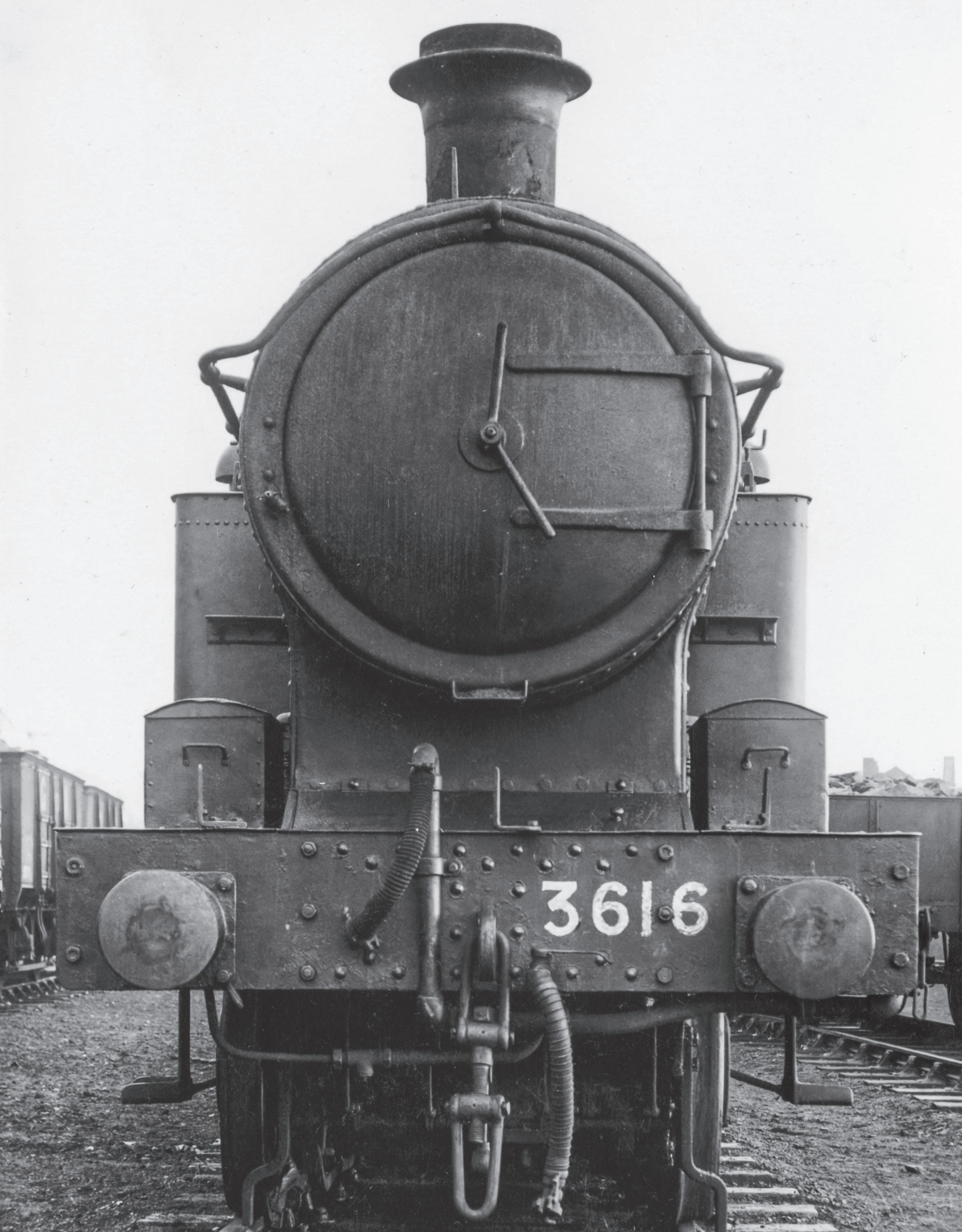
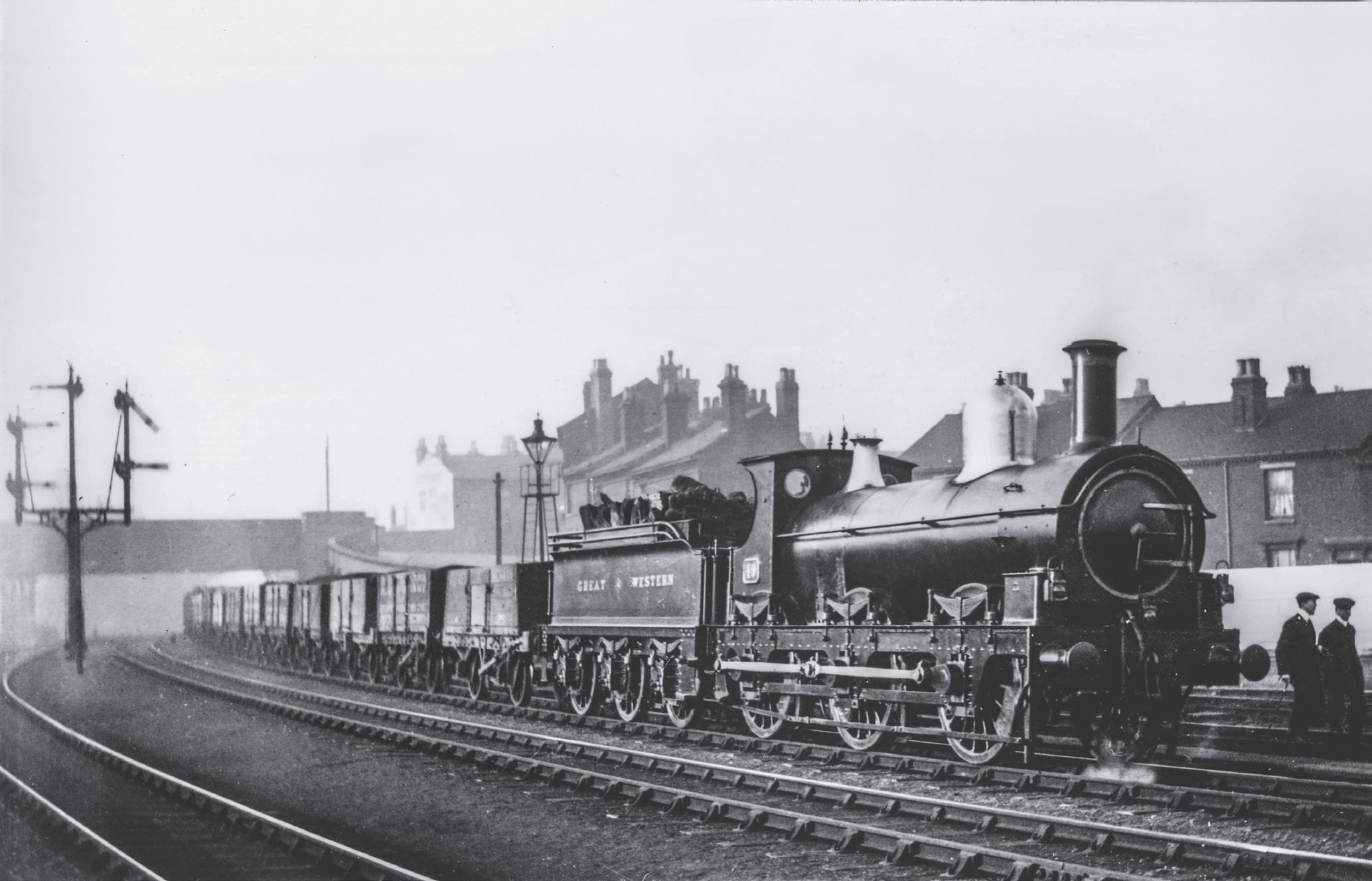
Opposite: Head on view of 36xx 2-4-2T No 3616. The origins of this design lay with William Dean who built an experimental 2-4-2T, No 11 in December 1900. This was an enlargement of the existing 2-4-0T ‘Metro’ (Metropolitan) design and proved immediately successful. In consequence an order for a further batch of the 2-4-0T design was cancelled and 20 engines to the 2-4-2T design were built in 1902. They took the numbers 3601 - 3620, the original No 11 renumbered as No 3600 in December 1912. Common between the prototype and the first (and second) batches built was a driving wheel diameter of 5’ 2” and two 17” x 24” inside cylinders and a steam reverser. There was a slight variation in overall length between the prototype and subsequent engines, whilst the third batch, Nos 3621 to 3630 built in 1903 were fitted with taper boilers. Intended for suburban work in the London and Birmingham areas the class had commodious cabs with excellent vision for both forward and reverse running, resulting in their nickname of ‘Birdcage’. (Damage to the windows at the rear from coal mainly when filling the bunker resulted in slightly smaller windows being fitted and coal bars added.) Slightly unusual for a tank engine was the fitting of scoops to allow for water to be picked up from troughs at speed. This caused an issue with No 11 on Rowington troughs; the inrush of water into the tanks was so great that the existing air could not escape quickly enough and the tank sides split. The remedy was to fit larger air vents to the sides and bunker. The class dominated the suburban scene until replaced by larger 2-6-2T types. For a while they might be seen in South Wales and also trains north of Chester. All were withdrawn in the early 1930s, No 3616 taken out of service in September 1933 and broken up at Swindon in January 1934. Its running number was bequeathed to a new pannier tank in March 1939. In the photograph there is a clear view of the toolboxes and also the enlarged vents atop the side tanks. HL03C 033 (56811)
Above: This is an interesting image for a number of reasons. Although appearing to be a ‘Standard’ or ‘Armstrong’ goods it is in fact a former Oxford, Worcester & Wolverhampton loco which in turn passed to the West Midland Railway and finally became GWR No 49 (formerly No 264). Note the substantial tie-bars at the back of the frames below the axle boxes. The tender is probably of the Dean 3,000-gallon type of which 397 were built between 1884-1906 or less likely a 2,500-gallon tender of which 301 were built in the years 1884-1903. Replacement of coal rails with side fenders commenced from 1903 but here it is in as-built condition. The tender is much younger than the engine as could easily have happened with tender rotation. The locomotive carries a roundtop ‘S2’ type boiler. We do at least know the date of the image, 17 February 1911, the train an Up goods at Hockley. Notice the dumb buffer wagon immediately behind the tender; dumb buffer vehicles were barred under agreement with the RCH from main line running as from 31 December 1913. Even so there were still a considerable number around after that date so there may have been exceptions. The loco coal is also worth a second glance, some massive lumps around the side of the tenders forming a genuine coal wall - breaking one of those would not be easy. The signals seen are all 5’ arms so refer to main lines and would be carried on wooden posts. It is quite likely the train was stationary when the view was taken; no driver at the spectacle plate or leaning outside the cab. The engine is carrying three headlamps across the bottom of the framing. This was the old code for a ‘through goods, mineral or ballast train’. Lamp codes were changed from 1 January 1918 to represent what we were later more familiar with, the new code for this working removing the need for a lamp over the right hand buffer. HL04B 013 (49633)

Another most interesting image. This is 2-8-0 No 2872 but with an oil tank. The number of this engine would change to 4800 soon after and so on paper was the first of the 2-8-0 conversions. The date for this is reported as November 1946 but as described on the previous page, we cannot always take the conversions dates to be strictly accurate. The conversions also had additional connections between the engine and tender for the oil-burners (steam supply to the heating coils in the tender), and modifications to the firebox and of course the oil tank within the tender. Following the Government order to cease work on conversions, trains continued to be worked with converted engines until literally the oil ran out. This was by now in the time of the new British Railways and whilst dieselisation was on the horizon it was not considered that the existing depot installations could be adapted to suit diesel traction. Accordingly the diesel railcars and diesel shunters operated by the (G)WR continued to refuel as before. Heavy oil fuel would be used once more on what was now the Western Region. This was on the initial gas-turbine No 18000 which continued with this fuel throughout the whole of its life. (This excludes the small diesel fuel engine fitted to No 18000 and utilised when starting.) Of passing interest is when in April 1958 57xx 0-6-0PT No 3711 was converted to burn oil, a rectangular bunker fitted into the former coal space. The work was done by Messrs Robert Stephenson & Hawthorns. No 2872 was originally built in November 1918 and survived in traffic until August 1963. HL 082E (98703)
The unseen Great Western
Cab view of No 5083 Bath Abbey, converted to burn oil in December 1946 and restored to coal November 1948. The view shows the ‘fireman’ sat on his padded seat (no such addition was provided for the driver who still had to make do with a tip up wooden seat). The firedoors have effectively been sealed although at the top there is a top inspection hole available. The fireman’s controls deal with the oil and steam flow. Beneath the footplate the insulated pipe carries the oil to the firebox burner. (The fall plate propped on to pieces of wood for the benefit of the photograph.) The view is clearly posed ‘cold’ as the steam gauge - top left - reads ‘zero’. Incidentally do note the regulator handle and reverser are not painted. Prior to nationalisation it was simple burnished steel. The trend to paint such items in red only came in post 1948. HL13D 065 66093
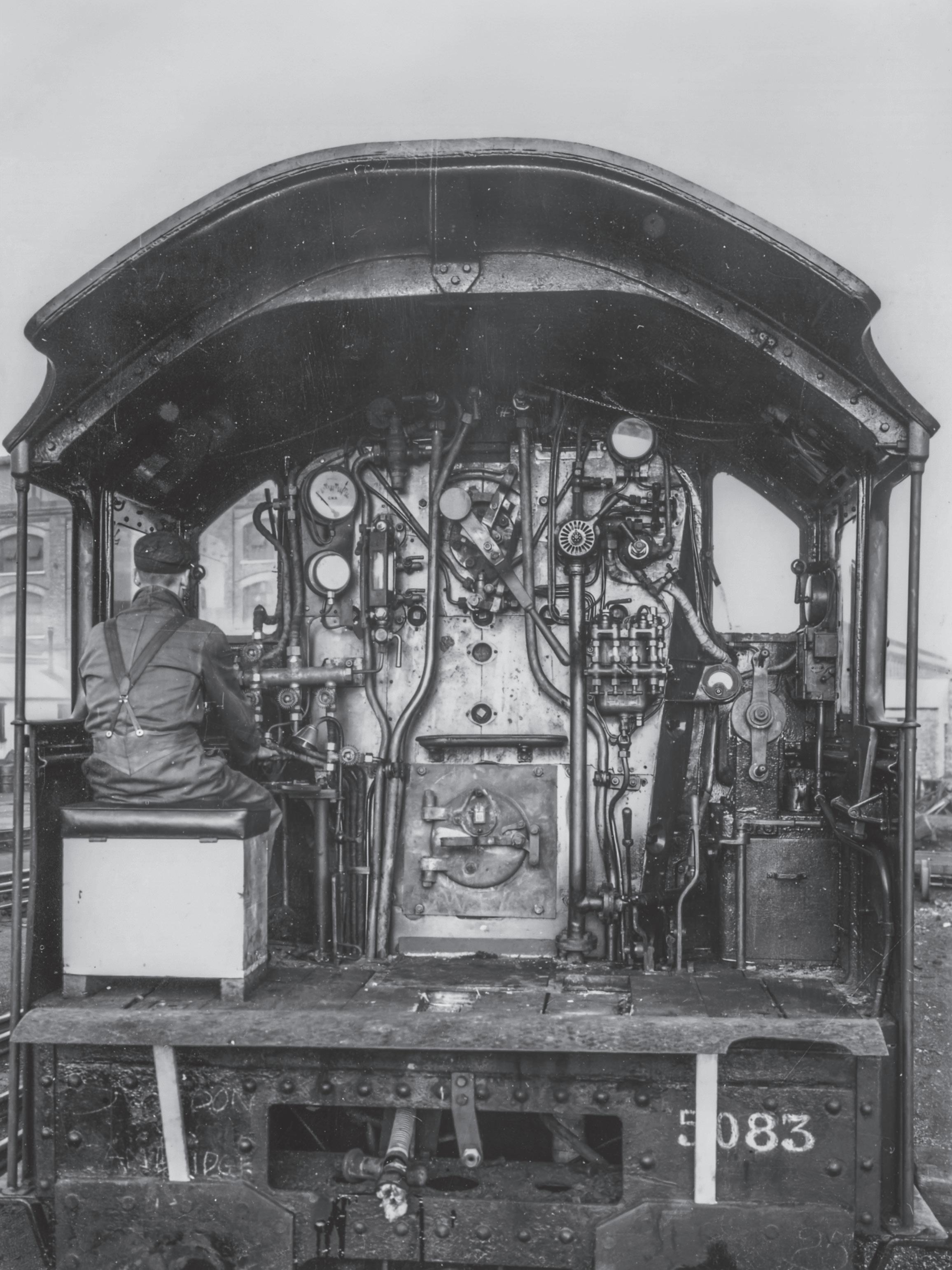
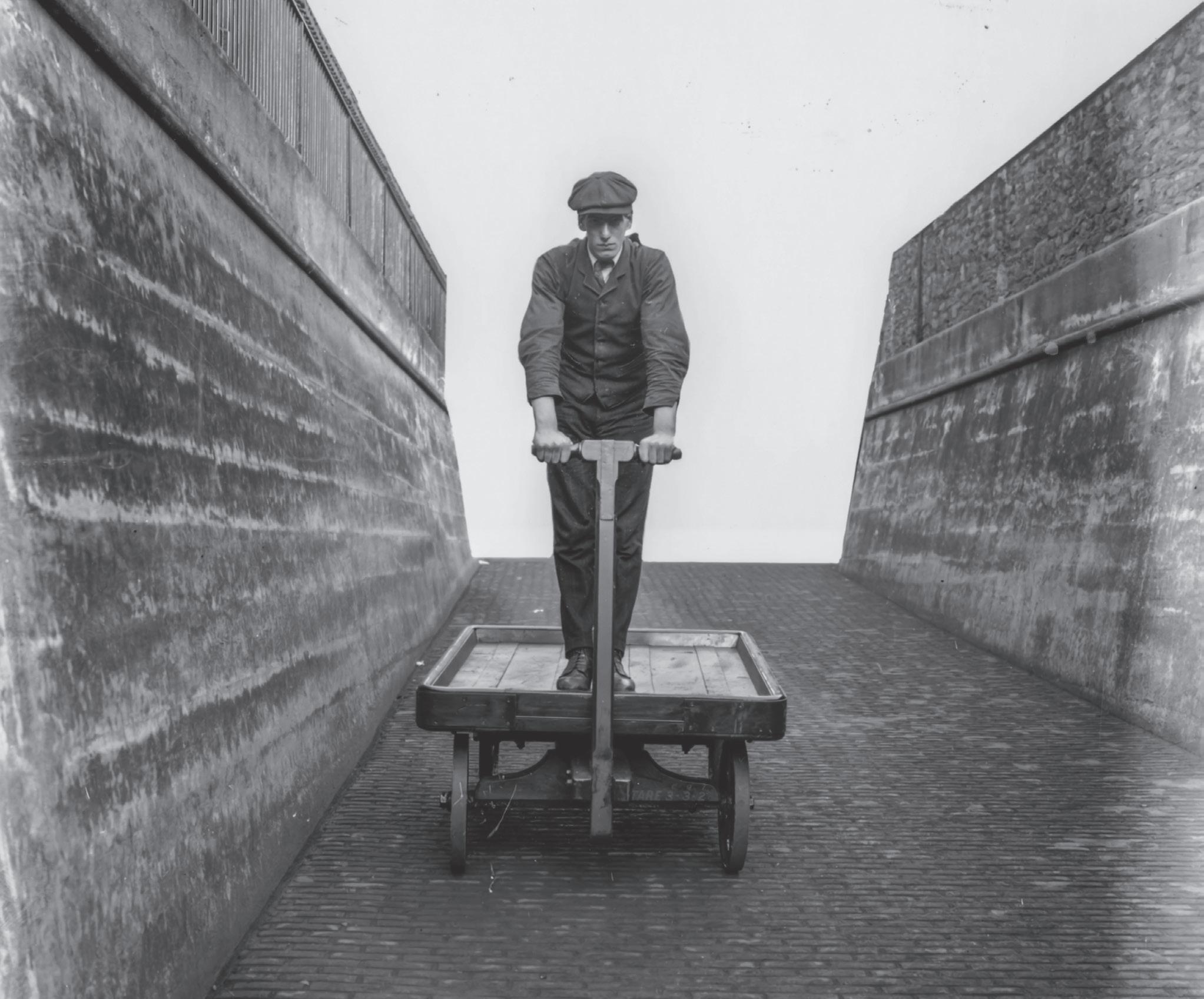
This is a book we hope unlike any other. Not unduly technical, not full of reminiscences and anecdotes, instead it is a small tribute to one man who was an avid collector of images (and hardware) making up what is known as the 'Harry' collection at STEAM - Musueum of the GWR, Swindon.
We say 'small' as the other tribute has to be to that wonderful railway the GWR. Mr Harry spend years collecting images of the railway he too admired; in excess of 27,000 views with many collected and simply put away in boxes hidden for years from other observers.
It is hoped that the contents of this book will be similarly unseen to the reader.
£14.95


